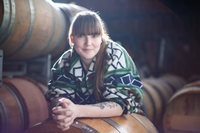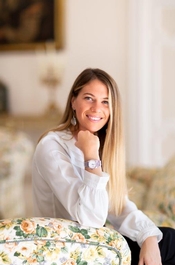This segment turns its attention across the Atlantic to honor the remarkable achievements of European women in winemaking. While previous columns in the “Breaking Barrels series” highlighted the accomplishments of their American counterparts, this installment reveals the profound impact of two visionary women who have shaped the viticultural terrain of Europe. From the storied vineyards of France to the picturesque hills of Italy, pioneers like Nea Berglund and Marzia Varvaglione redefine excellence in winemaking, emphasizing the global influence of female vintners.
Nea Berglund, CEO and Winemaker, Château Carsin
Nea Berglund is a dynamic force as both CEO and Winemaker of Château Carsin. Château Carsin is situated in the Côte de Bordeaux Cadillac appellation, which is in  the region of Entre-deux-Mers. At the helm of Château Carsin, she seamlessly blends time-honored winemaking traditions with contemporary techniques, resulting in exemplary wines that are rich in character. Notably, Berglund stands out as one of the rare figures in Bordeaux — potentially the sole producer — crafting red wines using all permitted grape varieties.
the region of Entre-deux-Mers. At the helm of Château Carsin, she seamlessly blends time-honored winemaking traditions with contemporary techniques, resulting in exemplary wines that are rich in character. Notably, Berglund stands out as one of the rare figures in Bordeaux — potentially the sole producer — crafting red wines using all permitted grape varieties.
Nea Berglund’s leadership and approach to winemaking not only shapes the future of Château Carsin but also Bordeaux winemaking.
Miranda Franco (MF): Can you share your journey into winemaking and how you got started in the industry?
Nea Berglund (NB): “I was born in Finland and lived there for about the first 20 years of my life. I was a normal kid from the countryside who spent her time at the stables and with friends. I studied economics at Aalto University (Helsinki) and started working in the restaurant business on the side. That’s when I realized the business wasn’t for me, and I got into wine. I had a great team of professionals around me and learned a lot. I’ve been doing harvests at Carsin since I was 15 years old, and while ‘studying’ at University, I spent all the harvests here in Bordeaux learning more.”
“In 2015, after graduating from Aalto and making a couple of big harvests here in Bordeaux, I went to Rutherglen, Australia, to work with Mandy Jones, a talented winemaker running her family estate, Jones Winery & Vineyard. After working with her and doing a quick harvest in Martinborough, New Zealand, I knew I wanted to pursue a winemaking career. I applied to a school in Bordeaux to do a Master’s in viticulture and enology. I graduated in 2018, and in 2019, I officially took over Château Carsin and have been running the show ever since.”
MF: Are there any specific winemaking traditions or techniques from your region that you find particularly fascinating or essential to preserve?
NB: “I’m not the best at talking about techniques as I often think, ‘the less, the better.’ I don’t do racking of our barrels, and most of the wines go to bottle unfined and unfiltered. I still value hand-picking on many of our wines and am proud to cultivate many original Bordeaux varieties. My father planted many less-known varieties in the 90’s, such as Sauvignon Gris, Petit Verdot, Malbec, and Carménère. These are all "local varieties" but are less known than the more common varieties, such as Merlot, Cabernet Sauvignon, Cabernet Franc, and Sauvignon Blanc. We are one of the only wineries in Bordeaux to produce a 100% Carménère or a 100% Sauvignon Gris. In the vineyard, I believe in authentic, old-school manual work. We are certified organic, so synthetic products are not used. Instead, we work our soils mechanically and our vines by hand.”
MF: Have you faced any misconceptions or stereotypes related to being a woman in the wine industry, and how have you overcome them?
NB: “This question makes me smile. I am what you could call ‘a tough cookie,’ but like all the women in a male-dominant field, of course I’ve faced my share of older men looking me down. For example, when I bought my share of the company and officially became the CEO in 2019, our neighbor was concerned and came to see me. He asked, ‘How do you think you’ll manage this winery independently since we know that women are incapable of running companies?’ Naturally, I was furious, but at the end of the day, comments like this only boosted me to be better, tougher, and do more. My neighbors and best friends here are also young winemakers – both women and men – and we don’t see any difference between us. In our neighborhood, women drive tractors, and men design new labels – and vice versa. The best way to overcome stereotypes is to concentrate on the work and surround yourself with dynamic individuals.”
MF: Can you share your perspective on the role of social media and digital platforms in promoting and marketing wines, especially those crafted by women?
NB: “Social media and digital platforms are huge for visibility and, therefore, success in our industry. I’m not the most active, but our Facebook and Instagram do have content weekly, if not daily — and I can see the impact on sales, too. We’ve sold wine over the internet for 20 years, and today, internet sales are about 10,000 bottles a year. This is almost 20 percent of our production! My social media strategy is to show the authentic farm life behind the bottles. Today, we appreciate honesty and transparency in everything. We want to know where our products come from and who’s behind them. From our social media, you can see what’s happening at Carsin at all times of the year, and sometimes, you also get realistic snaps from the bad days.”
MF: As a woman winemaker, have you noticed any shifts in consumer preferences or attitudes towards wines crafted by women?
NB: “In all honesty, I haven’t noticed consumer preferences towards wines made by women — but also, I never put myself on a pedestal because I’m a woman in a male-dominant field. I want people to buy our wines because they enjoy what’s inside the bottle and support our philosophy at the winery. I do realize, though, that I have some clients who like to buy my wines because they are made by me. A 30-something winemaker in Bordeaux is not the most common thing to see. I think all winemakers should have the same goal — making good wines. I believe in this and want to continue pursuing it.”
MF: What is your future aim as a winemaker?
NB: “In the past few years, I’ve become very interested in biodiversity and sustainability. We’ve planted fruit trees and hedges, changed our bottles to lighter ones, light bulbs to LEDs, etc. There’s so much to do! And I love that change and development are never finished. I’ve developed a lot of our activity here at Carsin. We do events, parties, and accommodations in our Carsin Cottage, and we produce many different wines in all colors: dry whites, rosé, red, sweet, and sparkling. And not to forget our non-alcoholic grape juice, barrel-aged balsamic vinegar, plenty of fruits and veggies, and eggs from our free-range chickens. Who knows what I’ll come up with this year? As a winemaker, I want to continue making good, fruit-driven wines that reflect our beautiful terroirs and sell them worldwide.”
Marzia Varvaglione, Head of Business Development, Varvaglione 1921
Marzia Varvaglione, Head of Business Development, represents the fourth generation  of her family’s business, which traces its origins back over a century. Today, she leads the business and marketing endeavors at Varvaglione 1921, a renowned winery nestled in the heart of Italy’s Puglia region. Through her leadership, Marzia contributes to reshaping the reputation of Puglia’s winemaking landscape, propelling her family’s legacy into a promising future.
of her family’s business, which traces its origins back over a century. Today, she leads the business and marketing endeavors at Varvaglione 1921, a renowned winery nestled in the heart of Italy’s Puglia region. Through her leadership, Marzia contributes to reshaping the reputation of Puglia’s winemaking landscape, propelling her family’s legacy into a promising future.
MF: Can you share your journey into winemaking and how you got started in the industry?
Marzia Varvaglione (MV): “I was born in the wine world. During summertime, when my sibling and I were young, we lived with our parents at the production plant in a small independent building. Summer after summer, we learned to live and grow in synergy with the vineyards, the winery, and all the wine activities surrounding wine production. I started to work in wine in July 2013. At that time, I used to live in Switzerland, but I was in Puglia for the holidays, and I was writing my Master’s thesis. It turned out that the company needed a person to substitute our export sales directly for three months. From then on…I never stopped; today, I couldn’t be myself without my job.”
MF: Are there any specific winemaking traditions or techniques from your region that you find particularly fascinating or essential to preserve?
MV: “In our area, Primitivo is still being grown using the “alberello technique”—similar to the goblin technique. It’s a pretty rare growing technique, but we love it so much. I particularly love the way we manage the canopy so that it seems almost like a hat sitting on top of the grapes and protecting the whole vine, grapes included, from the sun!”
MF: Have you faced any misconceptions or stereotypes related to being a woman in the wine industry, and how have you overcome them?
MV: “Sometimes, it happens, especially in some markets and if you are the youngest at the table. Some people call me the marketing girl, but it is funny because when people underestimate you, you can surprise them! We conquered the US market thanks to our 12e mezzo fashion edition created by the so-called ‘marketing girl.’ Here we are, celebrating this accomplishment. The only way to overcome these people is to work as a human being, not as a woman. At least, that’s what I do!”
MF: Can you share your perspective on the role of social media and digital platforms in promoting and marketing wines, especially those crafted by women?
MV: “Social media will continue to be the first communication channel because it is the only way producers have to overcome the boundaries and borders with the final consumers. Being yourself in life and on social media is the way to have success and build relationships with customers. But it’s very important to know ahead of going social who our target is and which tone of voice we want to use.”
MF: As a woman winemaker, have you noticed any shifts in consumer preferences or attitudes towards wines crafted by women?
MV: “Honestly, I can’t see any differences except for those given by the terroir, soil, grapes, and vintages.”
MF: What is your future aim as a winemaker?
MV: “I want to become the symbol and ambassador of my land, highlight Primitivo di Manduria, and tell the success story of the Primitivo grape. In the past, this variety was used only as a blending grape, whereas today, it has taken the stage and is becoming an icon that can age beautifully over the years.”
